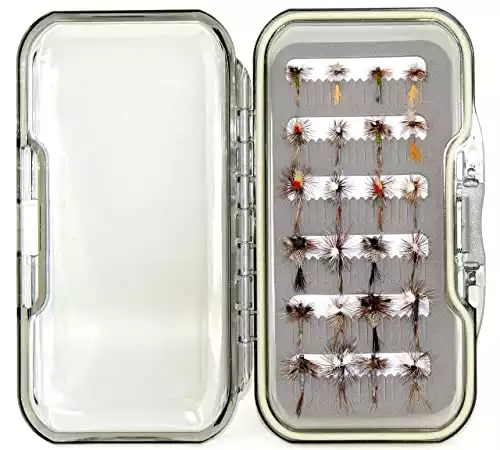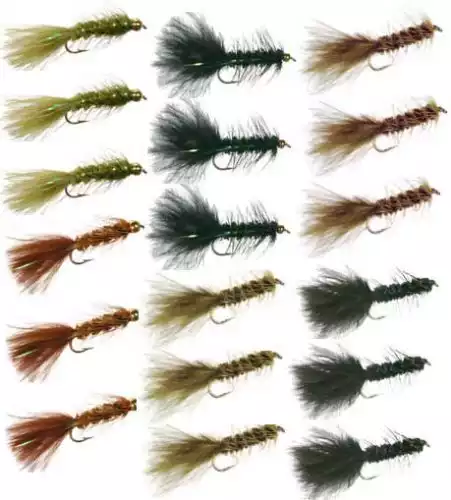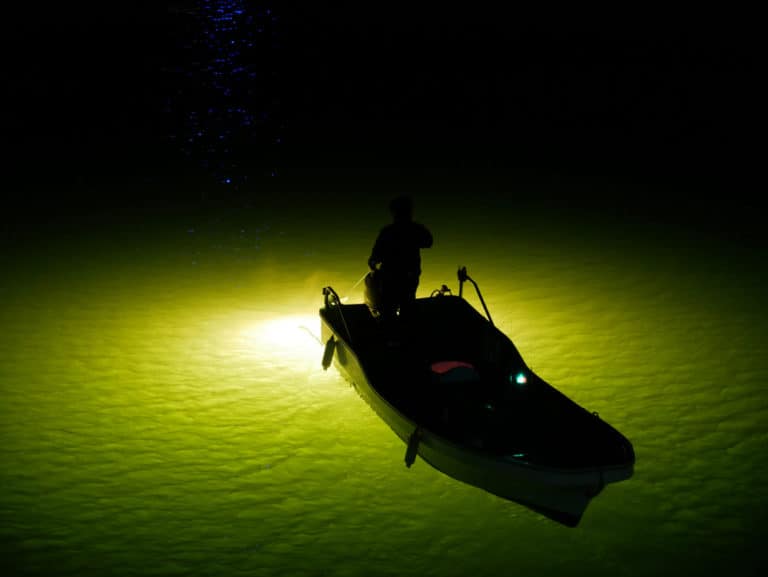5 Best Flies For Ice Fishing Trout
Ice fishing can be incredibly challenging, battling against the elements to try to catch the biggest fish you can. But the difficulty of ice fishing also makes it very rewarding, and one of the most satisfying types of fishing you can do.
But the challenges start before you even hit the ice, as choosing the right lure for ice fishing can be a tough decision. Still, finding the best ice fishing lure gives you a better chance of making a catch.
This is because different lures have different effects on the fish you want to catch, and some lures are more tempting than others. Different lures move around in different ways on the line, attracting fish in specific conditions.
Flies are an effective lure for trout. They’re artificial bait that mimics the insects that make up the trout’s diet. Flies are usually designed with bright and vibrant colors, and are submerged or float on the water’s surface to make baiting the trout easier.
Their lightweight design also means you can use flies to fish for trout upstream and in tighter spaces without being restricted.
Below, we’ve picked the best flies for ice fishing trout, as well as included a buyer’s guide for what to look out for when buying flies and answered some frequently asked questions.
Best Flies For Ice Fishing Trout Reviews
 Croch Trout Flies
Croch Trout Flies
Coming in a 3.5” wide waterproof tackle box constructed with durable double-sided ABS material and a rubber seal, the Croch tackle box is big enough to carry all 120 pieces of lure but still compact enough to fit into your fishing bag.
The lightweight assorted trout flies are divided equally into dry flies, wet flies, nymph flies and streamer flies. They are all hand-tied and hooked to sharp carbon steel hooks.
The assorted flies come in 21 different styles, 6 hook sizes, and 5 different subtypes, giving you plenty of options to experiment with.
While this tackle box is already compact, if you want to go for an even smaller set, Croch trout flies are also available in a 60-piece package that comes with 16 different styles.
Pros
- Versatile: These flies can be used in both still and flowing water.
- Suitable for all skill levels: This set of trout flies is suitable for both beginners and seasoned fishermen.
- Waterproof: For extra secure storage, this tackle box is also waterproof.
- Great colors: From red, to yellow, to black, this set features flies in lively and attractive colors, sure to catch any trout’s attention!
- Wide variety: With 21 different styles, 6 hook sizes, and 5 subtypes you’ll have plenty of flies to choose from, and plenty of opportunity to switch things up on the ice!
Cons
- Unravels: Some customers reported the flies unravelling after a few hours of use.
 Outdoor Planet Trout Flies
Outdoor Planet Trout Flies
Housed in a 3.2” wide double-sided waterproof tackle box, the Outdoor Planet Trout Flies come with 24 pieces, and are designed with a rubber sealing to keep out water, dirt, and debris.
Even if you drop your tackle box in the water, the float helps to keep the flies dry! Plus, it’s able to hold up to 100 different flies and is compact enough to fit in your fishing bag.
Fly sizes range from #10 to #18, with their overall weight being 3.2oz. The flies are also made of durable plastic tied to long lasting hooks with patterns that are guaranteed to attract trout.
These flies also help increase your catch, thanks to the flies’ easy-to-grip bodies that make them comfortable to hold for longer.
Pros
- Versatile: This tackle box contains assorted fly types that are suitable for lakes, rivers, streams, and ponds.
- Attractive patterns: Easily attract fish with the flies' colorful, attractive patterns.
- Lightweight: The flies’ lightweight build makes them comfortable and easy to grip.
Cons
- Flimsy: Some customers reported the flies unravelling and that the flies were not well-glued.
 Flies Direct BH Prince Nymph Assortment Trout Fishing Flies (1-Dozen)
Flies Direct BH Prince Nymph Assortment Trout Fishing Flies (1-Dozen)
With an assortment of hook sizes, the Flies Direct BH Prince Nymph trout flies are perfect to be submerged underwater.
These nymph flies resemble insects going through the stage of their life cycle which makes them particularly attractive to trout.
Made with high-quality craftsmanship and the best mustad hooks, you can be assured that these flies are tied to perfection.
Three of the fishing flies come in hook sizes 12,14,16, and 18 and are rigged with two flies.
The larger ones are to be used at the surface to attract fish, while the bottom ones are weighted and can be used at least 6 inches below the water.
Pros
- A range of hook sizes: These nymph flies come with assorted hooks with sizes ranging from 12 to 18.
- Lightweight: The lightweight build of these flies makes them easy to use.
- Handmade: These flies are hand-tied by professionals who take great pride in their craftsmanship.
Cons
- Poor packaging: Some customers reported that flies were missing when they opened the packaging, and that they needed to re-fluff the flies.
 Wooly Bugger Trout Fly Fishing Flies Collection - 18 Flies by Discountflies
Wooly Bugger Trout Fly Fishing Flies Collection - 18 Flies by Discountflies
One of the most popular fishing flies for trout, Wooly Bugger trout flies are known for their great performance underwater.
They can closely imitate underwater prey to attract trout, from leeches to nymphs.
Not only are they effective for catching trout, but they are also buoyant, durable, and available in 6 different fly patterns, mimicking several types of underwater prey.
These trout flies are also tied to sharp, high-quality Daiichi hooks in sizes 8, 10, and 12, and are all packaged in a compact tackle box.
Pros
- Excellent imitators: Their realistic design means trout can be easily fooled into thinking these flies are insects.
- Versatile: These flies work well in both rivers and lakes.
- High quality hooks: These flies are tied to high-quality, razor sharp Daiichi hooks.
- Effective colors: These flies come in 6 different colors and patterns, perfect for attracting all kinds of fish species including trout.
Cons
- Inconsistent sizes: Some customers have noted that the smaller brown flies are not the same size as the smaller black flies.
 Flyafish Vintage Trout Flies
Flyafish Vintage Trout Flies
Due to their incredible buoyancy Flyafish Vintage Trout Flies are an excellent choice for fishing on still waters.
The kit is also packed with 100 pieces, divided into 50 wet flies and 50 dry flies. All flies are attached with hooks with sizes ranging from 8, 10 and 12.
These fishing flies will not only catch trout, but smaller freshwater fish such as crappies, panfish, and sunfish.
Pros
- Wide variety of colors: With blues, pinks, oranges, and yellows, you’re sure to find an attractive color in this set!
- Lightweight: The lightweight build of these flies makes them easy and comfortable to use.
- Perfect for smaller fish species: These flies are not only great for attracting trout, but smaller fish like crappies too.
Cons
- Box is not waterproof: Be careful not to drop the tackle box in the water as it is not waterproof!
Buyer’s Guide
Color
One of the most underrated aspects of ice fishing is picking the right color for your lure. Of course, other aspects of fishing are important too, but the color of the lure you’re using could be the difference between a catch or no catch.
Primary colors are great in clear water, but if you’re using metal lures it’s important that they are not too brightly colored. More fluorescent colors work in cloudier waters, as they break through the dull color of the water.
In these kinds of waters, it’s good to use a variety of contrasting colors. This is not the case for clear water, where using one block color is more effective. If you’re using metallic colors then gold is the better option in cloudy waters, while silver is better in clearer waters.
It’s also important to consider the thickness of the ice. With thinner ice, you should use more primary or natural colors as the brightness shining through the ice will make the colors stand out.
Meanwhile, with thicker ice you should go for brighter, flashier, metallic colors. This also applies to any snow cover too. The thicker the snow, the brighter your lure needs to be.
When snow or ice is thick, it prevents light from traveling into the depths of the water, and this is why bright colors are needed to attract the trout. A good color combination would be a fluorescent orange and a bright, metallic color which matches the color of the water.
Water depth is also important to consider as well, as the deeper you go, the darker the water gets. As well as the surroundings becoming a bit duller, the depth of the water will affect how light is seen.
For example, red flies will appear to be grey even in shallow water. This change happens with all colors eventually, but blue and green lures tend to retain their color the longest. Fluorescent and glow colors are also able to maintain their color at greater depths than standard colors.
The time of day and the level of sunshine are also factors to consider. One of the most critical things about the color of your lure is how bright it is to fish. They not only need to be interested in the lure, but also able to see it clearly.
On cloudy, dark days you will need a brighter fly than you would use on a sunny day, and the same applies when you’re fishing at sunrise or sunset as well.
As you can see, many aspects can affect the optimal color for lures, and if you’re not having any luck it’s always worth experimenting with colors to see what works for you.
Fish may be unpredictable but following these guidelines and using the most appropriate color according to what conditions you’re fishing in should give you results.
Style
The three main types of fishing flies are dry flies, nymph flies, and streamer flies. Dry flies are the most common type, and they are so named because they drift along and float on the water rather than go into the water.
They only sink into the water when bit. Nymph flies imitate small insect larvae and are great flies to use all year round. They are used under the water where the larvae live. Streamer flies, meanwhile, are the largest type and are normally used for fish that look for larger underwater prey.
Size
When we talk about size, we’re referring to the size of the hook to which a fly is attached. The bigger the number, the smaller the fly. So, for example, a size 16 means the fly is smaller than the fly attached to a hook size 14.
When picking the right flies, hook size needs to be taken into consideration too. Typical freshwater hook sizes range from 32 to 4.
Type of fish
You are limited to a certain number of fish when ice fishing, as not a whole lot of fish species spend their time underneath the ice.
The most common fish you’ll find while ice fishing is the walleye, so it’s important to consider the best lures for these kinds of fish. Walleye can be incredibly fast and put up a fight, but if you do catch one it’s very rewarding! They often move in groups too, so it is possible to catch more than one walleye in one sitting.
Yellow perch and tullibee are other types of fish that you commonly find when ice fishing. You’re less likely to encounter these than the walleye, but it’s always very satisfying when you do find one.
They’re also tasty fish which makes them a great permanent catch. They also don’t put up as much of a fight as walleye. Unlike the eelpout, these are incredibly tough fighters, but a rewarding and tasty catch.
They’re often referred to as freshwater cod! These can be frustrating to fish though as they often spin on their way back up the hole in an attempt to escape, and this could tangle your whole line.
Of course, trout are another popular type of fish when ice-fishing, and the flies we’ve mentioned on this list are particularly good for catching trout. They vary in location, so before you go ice-fishing for trout, do your research to make sure the area you plan on going supports them.
This is also the case for panfish as well, but can be applied to any fish you plan on catching. Do your research on your chosen location to see what type of fish you’re likely to find there, and you can adjust your lures accordingly to make sure you have the right equipment.
Frequently Asked Questions
Why should I use fishing flies?
You should use fishing flies because they are effective in attracting fish. The best trout fishing flies closely resemble the insects the trouts eat.
Plus, the gear used for fly fishing is lightweight and easy to handle. Also, fishing flies are reusable unlike live insects, so they are the better economical choice in the long run.
How do I choose the best color flies?
As we discussed above, it is hard to lure in your fish when you are ice fishing and that is why the right color fly is crucial. You don’t want it to be too bright that it looks unnatural and deters the fish from approaching it, but if it’s too dull the fish won’t pay it any attention.
To choose the best color you need to adapt to your surroundings and consider how much light is getting into the water below.
As we have mentioned, ice thickness, snow cover, sunshine and the color of the water can affect how clearly the fish sees the lure, and these are all factors to consider when planning your fishing trip.
Conditions can also change quickly so it’s good to be well-prepared with a different range of colors. This gives you the option to change your lure to suit the conditions you find yourself in. It’s also crucial to experiment with colors to see what works for you.
Can I use my ice fishing lures again?
As long as they remain stable and solid, then yes you can! But if they become damaged, throw them away immediately. You should also keep an eye on the color, as once the color has faded the lure may no longer be effective.
Again, being prepared with a few different lures is key, just in case you do have to replace broken or faded lures.
When Should I Use Fishing Flies?
You can use nymph flies all year long, however regular fly fishing is best done during spring, late summer, and fall. This is due to the trout’s diet, and anglers do find more success in the warmer months.
Trout are attracted to mosquitos and other insects that are out in force during warmer weather, which makes the trout more likely to bite, and you more likely to have a catch!






